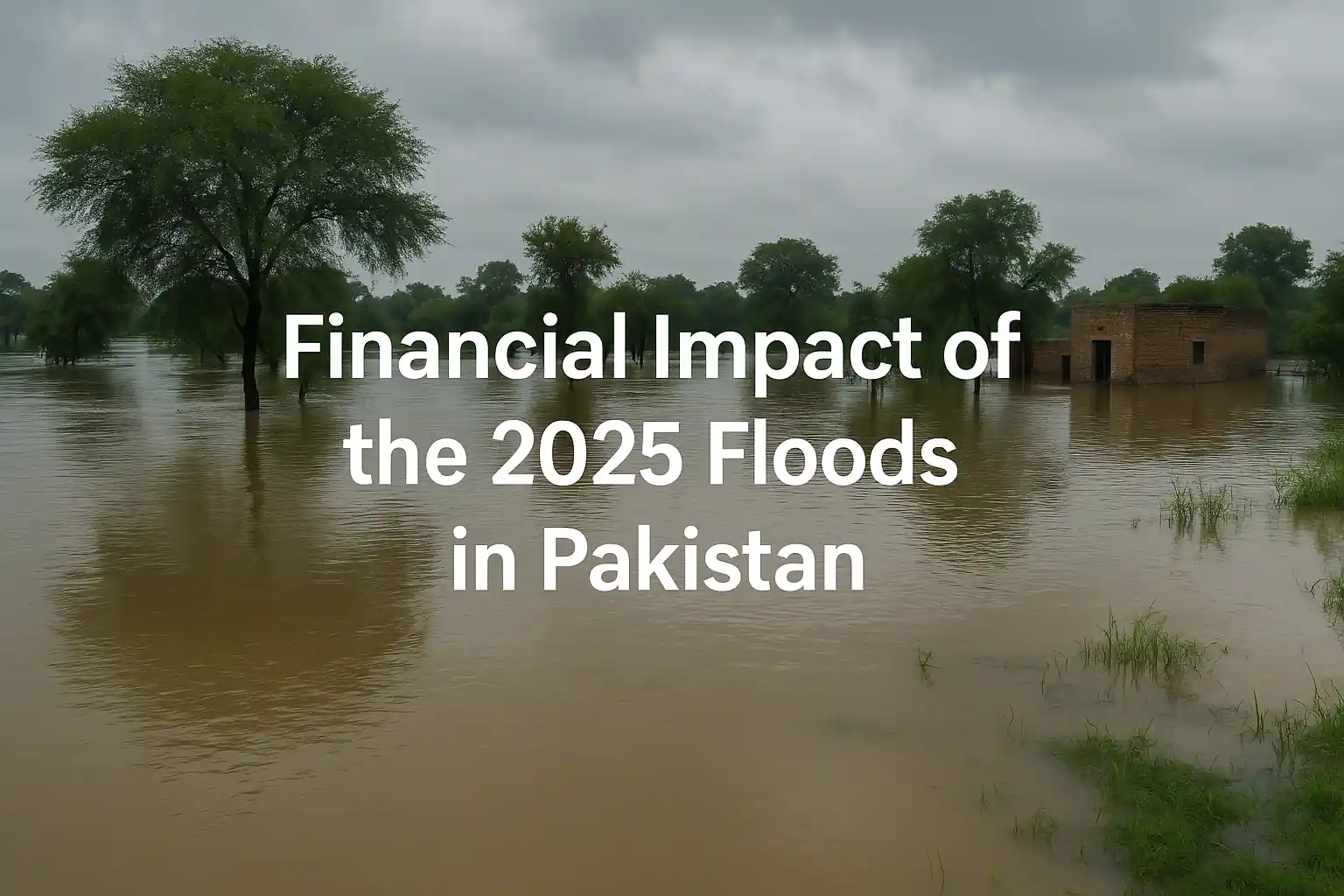Floods are not only a disaster for people and homes, but they also create a very big problem for the money system of a country. In August 2025, heavy rains and a rare cloudburst caused floods in many parts of Pakistan, especially in the Khyber Pakhtunkhwa region. These floods destroyed houses, shops, roads, and farms. Hundreds of people lost their lives, and thousands lost their belongings. While the human loss is the saddest part, there is also a large financial story behind this disaster.
What Happened in the 2025 Floods?
In mid-August 2025, heavy rains and a sudden cloudburst hit Buner and nearby districts in Khyber Pakhtunkhwa. Within a few hours, rivers overflowed, bridges broke, and whole villages were covered with water and mud. Reports say more than 600 people have died since the start of the rainy season in June, with over 300 deaths in just a few days of August. Thousands of families are now without homes.
The damage is not only about people losing their houses. Shops, schools, hospitals, and roads were destroyed too. This means that the whole system that helps people earn and spend money has been badly hurt.
How Floods Affect the Economy
When we talk about finance, we talk about money. A flood is not only about water; it also shakes the money side of life. Here is how:
-
Damage to Property
-
Houses, shops, and markets were washed away.
-
People lost their savings because their belongings are gone.
-
Businesses will need lots of money to start again.
-
-
Loss of Jobs
-
Many people worked in small shops, farms, and transport. When these places are damaged, jobs disappear.
-
Families lose their income and cannot buy basic things.
-
-
Damage to Farms
-
Pakistan depends on farming for food and exports. Crops like wheat, maize, and rice were damaged.
-
When crops are lost, food prices rise. This is called inflation.
-
-
Impact on Roads and Transport
-
Floods destroyed roads and bridges. Trucks and buses cannot move easily.
-
When transport stops, goods cannot reach markets. This makes products cost more.
-
-
Effect on Government Spending
-
The government now needs to spend billions on rescue, relief, and rebuilding.
-
This money is taken from the national budget, which could have been used for schools, hospitals, and new projects.
-
Comparing 2025 Floods with the 2022 Floods
Pakistan faced very bad floods in 2022 when one-third of the country was underwater. That disaster caused more than $30 billion in damages. The 2025 floods are not as widespread, but they are still very costly. Early reports suggest damages worth billions of rupees.
This shows that Pakistan’s economy is still very weak against climate change. Each time floods come, progress is pushed back by many years.
The Human Side of Finance
Finance is not only about big numbers. It is about how people live. For example:
-
A farmer who lost his wheat crop has no money to feed his family.
-
A shopkeeper whose store was washed away has no income.
-
A child who cannot go to school because the building is destroyed loses future chances for a better job.
When we add all these small stories, we see a very big financial crisis.
How Floods Affect National Finance
-
Currency Value
When a country faces a disaster, it often needs to borrow money from other countries or world banks. Too much borrowing can make the country’s currency weaker. -
Imports and Exports
-
Pakistan exports farm products, textiles, and minerals. Floods reduce production, so exports fall.
-
At the same time, the country may need to import more food and materials, which costs extra.
-
-
Inflation
Prices of food, fuel, and goods rise quickly after floods. Poor families suffer the most because they already spend most of their income on food. -
Government Debt
To rebuild, the government borrows money. This increases the debt. In the long run, paying back this debt with interest can create more financial pressure.
Financial Relief and Aid
After the 2025 floods, both the government and international aid groups started giving money, food, and tents to the affected families. Relief funds are important, but they are often not enough to cover everything.
The government also promises compensation for destroyed houses and farms. But past experiences show that not all families get help quickly. Corruption and delays can make recovery slower.
The Role of Insurance
One way to protect finance in disasters is insurance. In many developed countries, people insure their homes, crops, and shops. If a disaster happens, the insurance company pays money to rebuild.
In Pakistan, very few people have insurance. This makes them more vulnerable when floods hit. Building a strong insurance system for farmers and small businesses can reduce financial losses in future disasters.
Climate Change and Future Finance
Experts say that climate change is making floods more common and more dangerous. For Pakistan, this means that financial planning must change.
-
Investment in Flood Protection: Building stronger dams, drainage systems, and early warning networks.
-
Green Finance: Shifting money towards eco-friendly projects that reduce the effects of climate change.
-
Disaster Funds: Setting aside money each year for emergencies instead of only reacting after a disaster.
Lessons for Finance in Pakistan
-
Be Ready Before Disaster
Saving money, creating disaster funds, and investing in protection can reduce future costs. -
Support Farmers and Small Businesses
These groups are the backbone of the economy. Helping them recover faster helps the whole country. -
Transparency in Aid
Money sent for relief must reach the people who need it. Good management builds trust and reduces corruption. -
Education and Awareness
Teaching families about savings, insurance, and disaster planning helps them face future challenges better.
Conclusion
The 2025 Pakistan floods show once again how disasters affect not only people’s lives but also a country’s money system. Finance is not just about numbers in banks; it is about people’s homes, jobs, and food.
Floods destroyed crops, shops, and homes, caused inflation, and forced the government to borrow more money. At the same time, they opened discussions about insurance, green finance, and better planning for the future.
If Pakistan can learn from this disaster, invest in stronger systems, and manage its money wisely, then future floods may not cause as much damage. Finance is the key to recovery, and recovery is the key to survival. Read More















Leave a comment